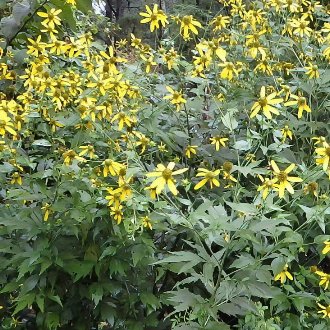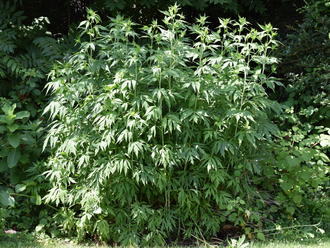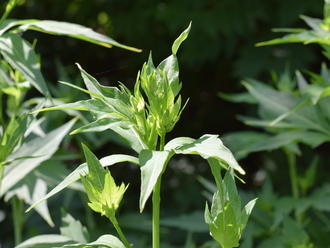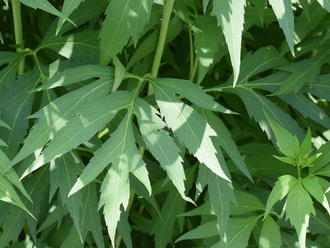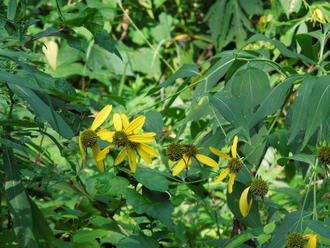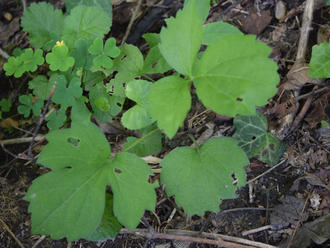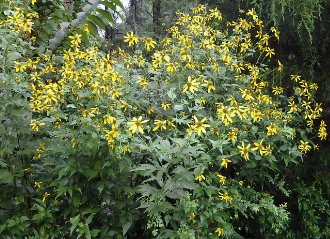Cutleaf Coneflower (Rudbeckia laciniata L.)
Also known as sochan, green-headed coneflower, tall coneflower, thimbleweed.
↑Summary
An atypical Rudbeckia, a tall rhizomatous perennial with large yellow flowers, found in moist, partly sunny habitats.
↑Range - Expand
| Legend | Color |
| Native | |
| Native or Not Present | |
| Introduced or Not Present |
This tentative map is based on our own research. It may have limited data on Canada and/or Mexico, and there is some subjectivity in our assignment of plants as introduced vs. expanded. Read more in this blog post.
Although this plant occurs somewhere in each of these regions, it may only occur in a small part of some or all of them.
↑Habitat
Found in part sun in moist habitats with rich soils, often on sites prone to flooding from moving water. Most common natural habitats include streambanks, lakeshores, clearings or gaps in floodplain forests, and wetland margins. Also occasionally found in rich, mesic upland forests, particularly in the Appalachians. Also found in anthropogenic habitats, including suburban gardens and disturbed bottomland sites such as forest edges and small forest fragments.
Prefers moist to wet soil high in nutrients, close to neutral in pH, and loamy to silty in texture. It can grow in clay soils but its growth is inhibited. Usually found in habitats with some history of disturbance, most frequently from flooding but occasionally from other types of disturbance.
Tolerant of temporary flooding, including heavy, fast-moving floods of rivers or streams that deposit new soil; often favors such habitats as it is better-adapted to such conditions than most other species. Tolerant of, and often benefits from mowing one or more times a season, especially mowing that is timed during the dormant season where the plant has little upright growth.
In the southernmost regions of its range, especially the arid southwest, this species is mostly restricted to high-elevation habitats. In the humid southeast it can occasionally be found at lower elevations, but is more restricted to moist, rich sites. This plant becomes more tolerant of a wide range of conditions in the central to northern parts of its range.
Humans have probably increased the habitat for this species through increasing disturbance and habitat fragmentation in bottomland areas, as well as through increasing runoff and thus increasing severity of flooding along streams and rivers, but human activity has also threatened it in some habitats as it is highly sensitive to ground level ozone.
This species is the most shade-tolerant, most flood-tolerant, and least drought-tolerant of the Rudbeckia species in most of its range, and is a bit atypical among its genus, although it shares more in common with the western species that it is more closely-related to.
↑Life Cycle
Cutleaf coneflower is a long-lived perennial that often forms dense colonies by spreading vegetatively, through rhizomes, but also reproduces readily by seed.
Seeds germinate readily in exposed soil, usually in late spring or early summer. Young plants are small and slow to get established. Plants usually do not flower in the first year and usually only grow as a basal rosette, sometimes only a few inches in width. Seedling survival is highest in moist, humid coniditions. Seedlings are highly shade-tolerant, growing slower but still surviving even if shaded by other vegetation.
Second-year plants grown in sufficient light usually reach full height, but heavily-shaded plants may take three or more years to reach their final height. Upright stems have leaves with deep lobing, which reduces drag during flooding events with fast-moving water, while still allowing a large leaf surface area; this leaf shape thus balances adaptation to habitats that are both partly-shaded and located along flood-prone rivers or streams. Established plants continue to expand outward, forming colonies on favorable sites, and often expanding vegetatively into better moisture, soil, or lighting conditions. Vegetative reproduction can also allow this plant to move short distances and persist as soil condition change due to erosion and/or deposition of new material from floods, a common phenomenon in floodplains.
Plants flower in summer and seed usually matures by early fall, with small numbers of late-blooming flowers having their seed mature later. By fall, stems are usually heavily leaning. Tall plants can often drop their seed farther than the reach of the main plant's rhizomes, leading this plant to expand slightly farther by seed than it does rhizomatously. This phenomenon makes it more likely that colonies maintain some genetic diversity instead of just being a vegetative clone of a single plant, although it is also possible to find large vegetative colonies of a single indiviudal.
Stems die down after the plant sets seed, but basal foliage persists and can be semi-evergreen in mild winters. New foliage emerges early in spring, and grows quite tall and thick rapidly, allowing this plant to compete successfully against other early-emerging plants.
Seeds are distributed by multiple means; most are dropped initially near the host plant, but some stick to animal fur. The seeds are light enough that under dry conditions, they may be blown by wind. Ants may carry the seeds over short distances, and mice may carry the seeds slightly longer distances in order to cache them. Birds may also carry the seeds slightly longer distances. Humans can also play a significant role in seed dispersal, as this plant is often grown intentionally.
Seeds require a period of cold dormancy, after which they may germinate in the next growing season. Although many seeds germinate in their first growing season after cold dormancy, this species also forms a short-term seed bank, with some seeds continuing to germinate in the second or third seasons. The staggered germination can allow this species to take advantage of soil disturbance even when it follows a year where seed production was poor due to drought or an ill-timed disturbance.
↑Faunal Associations
The flowers attract a diverse array of pollinators, including both long- and short-tongued bees, numerous wasps, butterflies, skippers, moths, and flies.
The foliage is eaten by numerous insects, many of which specialize on this and closely-related species. The beetle Sumitrosis inaequalis, and the larvae of the sawfly Macrophya simillima eat the foliage. The aphid Uroleucon rudbeckiae sucks the sap of this and related species. The stems are mined by the larvae of the fruit fly Strauzia intermedia. The gall midge Asphondylia rudbeckiaeconspicua forms conspicuous galls on the buds in spring and the flowers in summer; this midge is in turn eaten by parasitic Torymus wasps.
Lepidoptera species whose larvae eat this plant include the moth Marmara auratella, the coneflower borer moth (Papaipema nelita), the silvery checkerspot (Chlosyne nycteis) butterfly, and in the southwest of its range, the moth Epiblema arizonana. The florets are also eaten by the larvae of the wavy-lined emerald moth (Synchlora aerata) and the moth Eupithecia miserulata.
The seeds are eaten by birds, including the American goldfinch, although these seeds are not usually a preferred food source for these birds due to their smaller size. Mice also eat the seeds.
The foliage has some toxicity to mammals and thus tends only to be browsed by them in small quantities.
↑Control
Although this species has a wide native range in North America, outside its native range it has a high potential to become invasive. It has become invasive in Europe, Central Asia, and East Asia, especially Japan, and there are also introduced populations in Taiwan, Indonesia, and South America.
This species is difficult to control once introduced, due to its rhizomatous nature, high seed production, and persistence in the seed bank; it is best to prevent its introduction into new areas and only grow it in or directly adjacent to its native range.
↑Uses
The leaves of this plant are traditionally eaten by the cherokee. The leaves are typically harvested in spring and either cooked, typically by boiling them and then frying them in oil, or are dried and/or frozen and consumed in winter. The root as well as tea made from the leaves have both been used in traditional medicine.
This plant is sometimes planted in gardens, where it is valued for its showy yellow flowers, distinctive foliage, and ease of growing. Its use in garden settings is limited by its aggressive nature, large size, and its tendency for the stems to flop over.
Some cultivars exist, but we discourage the use of cultivars as many of them have been modified in such a way that makes the flowers inaccessible to pollinators. 'Hortensia', often called "golden glow" or "goldenglow" is one such cultivar that we recommend avoiding, due to it having dense rays that prevent pollinators from reaching the flower tubes.
This plant is particularly useful for ecological restoration projects in disturbed bottomland habitats, such as riparian restorations. Its aggressive root system is effective for holding soil, and it is both easy to seed into an area and easy to transplant. It competes favorably against invasive plants and has a high value to wildlife.
Where their ranges overlap, this species, together with canada goldenrod (Solidago canadensis), can be used in a bioeradication scheme for tree of heaven (Ailanthus altissima), a tree that is invasive in North America; these flowers have dovetailing bloom periods, and both attract the ailanthus webworm moth (Atteva aurea), which, if present in sufficient numbers, can stress or kill Ailanthus trees.
↑Related Plants
There are numerous other Rudbeckia species that co-occur with this one; all are native to North America although some have been introduced to other parts of the continent beyond their native ranges.
Genetic studies have placed this species as probably being most closely related to a group of western Rudbeckia species: california coneflower (Rudbeckia californica), Klamath coneflower (Rudbeckia klamathensis), waxy coneflower (Rudbeckia glaucescens), and western coneflower (Rudbeckia occidentalis). This is the only species of that grouping to also be found in the east. Their ranges do not overlap with this species except for R. occidentalis which overlap in a small part of western Colorado.
↑Notes
This species is sometimes referred to by the common name "tall coneflower", but this common name can also refer to the rough coneflower (Rudbeckia grandiflora). The name "thimbleweed" is also ambiguous, referring more often to several species of the Anemone genus. We recommend avoiding these names because of their ambiguity.
The name "cutleaf coneflower" is both unambiguous and descriptive of this species' leaf shape. Although other Rudbeckia species, as well as other genera called "coneflowers", also have lobed leaves, this species tends to have the most deeply- and intricately-lobed leaves of any of the Rudbeckia species in its range. The common name "Sochan", of Cherokee origin, is also a good option.
↑Links & External Resources
• Rudbeckia laciniata (Cutleaf Coneflower) | Illinois Wildflowers (About This Site)
• Rudbeckia laciniata (Cutleaf Coneflower) | USDA PLANTS Database (About This Site)
• Rudbeckia laciniata | Go Botany (About This Site)
• Rudbeckia laciniata (Cutleaf Coneflower) | Missouri Botanical Garden Plant Finder (About This Site)
• Rudbeckia laciniata | Biota of North America Project (BONAP) (About This Site)
• Rudbeckia laciniata | NatureServe Explorer (About This Site)
• Rudbeckia laciniata | Flora of North America (About This Site)
• Rudbeckia laciniata | Missouri Plants (About This Site)
• Cut-leaved Coneflower | Maryland Biodiversity Project (About This Site)
• Cut-leaved Coneflower (bipinnata) | Maryland Biodiversity Project (About This Site)
• Cut-leaved Coneflower (humilis) | Maryland Biodiversity Project (About This Site)
• Cut-leaved Coneflower (laciniata) | Maryland Biodiversity Project (About This Site)
• Rudbeckia laciniata (Cut-leaf Coneflower) | Minnesota Wildflowers (About This Site)
• Rudbeckia laciniata L. (Cut-leaf Coneflower, Common Cut-leaf Coneflower, Green-headed Coneflower) | Digital Atlas of the Virginia Flora (About This Site)
• Rudbeckia laciniata L. var. bipinnata Perdue | Digital Atlas of the Virginia Flora (About This Site)
• Rudbeckia laciniata L. var. humilis Gray (Southeastern Cutleaf Coneflower) | Digital Atlas of the Virginia Flora (About This Site)



